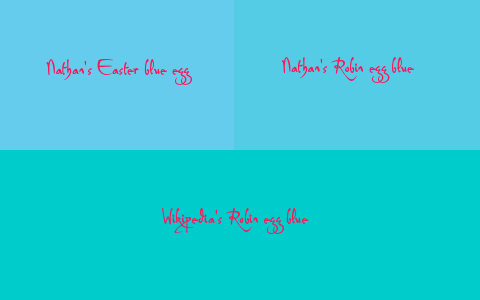
In a recent paper with Silvia Zuffi and Carla Brambilla on color readibility, we wrote that you can perform psychophysics on the Web even if it is uncontrolled, because the errors average out and you can recruit a large crowd of observers. Sure, Carla had to prune some non-sense outliers, but statisticians know how to do that correctly.
On the other hand, the Germans have the saying "even if a gazillion flies eat shit, this does not mean that shit tastes good." In the color readability test, the task was sufficiently arcane that we can safely assume that the subjects had some domain knowledge and knew what they were doing. But what if the task is so easy and natural that anybody can perform it. Do errors average out when you do a viral Web experiment? Let us find out!
Now that it is Easter, you can go to Nathan's post on his On-Line Color Thesaurus and enter Easter egg blue. His tool will return color #66CCEE shown above. Hmmm. Where does that color come from? No, he did not make up the name. What he did was to use the Internet and his Color Naming Experiment to have a crowd come up with that name. He showed them a patch of #66CCEE and got back Easter egg blue.
How authoritative is this datum? We can search Easter egg blue on the Internet and we get 8,050 hits. A relatively low number, and not a clue on the name's history. We get a better datum by checking the raw data on the server; the number of people who proposed that name where only three. Hardly an authoritative number.
For privacy reasons we do not collect any demographic data from the Web site, so we cannot go back and ask these three people how they came up with the name; we have to come up with a plausible argument.
Easter is not blue. Here in the USA we have the concept of holiday blues, but it refers to the time from Thanksgivings to Christmas. And what do eggs have to do with it? Is it blue eggs then? Indeed, when you tried the query on the on-line color thesaurus you got robin egg blue as a synonym. But when you click on it, you are told it is color #55CCE5. Here are the two color side by side

They are pretty close, but do not match. The Wikipedia thinks Robin egg blue is color #00CCCC, but they do not give a source.

 A different approach is needed. Human memory is not cast in concrete, it has to be continuously refreshed by reliving memories. When a human is isolated, his memories are not checked and it drifts. And because memory is associative, we can easily get side-tracked by incorrect associations.
A different approach is needed. Human memory is not cast in concrete, it has to be continuously refreshed by reliving memories. When a human is isolated, his memories are not checked and it drifts. And because memory is associative, we can easily get side-tracked by incorrect associations.
It is possible, that our famous three subjects had at some point heard Easter Blue, but because it does not make sense in isolation, they somehow added egg. Indeed, The ISCC-NBS Color Name Dictionary lists an Easter Egg Yellow, but no Easter Egg Blue. My wild guess is that the three subjects were thinking turquoise.
Turquoise is a strong hint. The next stong hint is: it is not a solid color at all.
If you cross the Death Valley from west to east and after enjoying the famous opera at Amargosa Valley drive north on Highway 95, on your right you will drive along the Tonopah Test Range, and finally hit Tonopah. In Tonopah you will find the Easter Blue Mine owned and operated by Danny and Dean Otteson. You can see the very approximate location on this map, and here is information on Nevada Turquoise.
A Web site on the New Nevada Turquoise Trail has a page on Easter Blue, depicting a number of Easter Blue stones you may want to check out. They explain: "The Easter Blue mine is located northwest of Tonopah, Nevada a few miles from the Royston district. Turquoise from this claim has also been called Blue Mountain and Blue Gem. Compared to some of the other deposits in Nevada, the Easter Blue was never considered a large producer and changed hands a number of times. It was discovered in 1907 and the first material found was a fine blue color, usually occurring in thin veins, later the mine produced a blue green turquoise with a light to dark brown matrix. A very pretty turquoise when set in silver."
In reality, naming colors is a difficult research task. To elicit your subjets to suggests the Easter Blue name, you have first to be able to present a large mottled spider web with light blue centers in the webbing. …And no, Easter Blue is not in Nathan's on-line color thesaurus. Instead, it suggests you to use Pastel Blue, which is #7FC5EB and not a synonym of Easter Blue. Lots of research still remains to do.
Happy Easter!





No comments:
Post a Comment